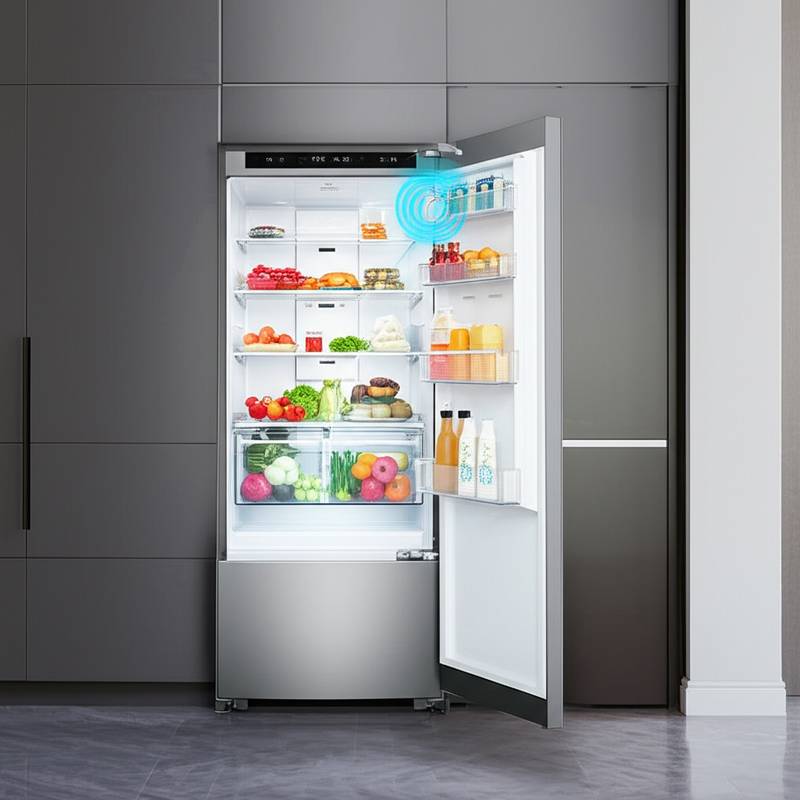Smart Refrigerators Detect Food Spoilage Before Consumption
Smart homes continue to advance, with the kitchen emerging as a central hub of intelligence. Recent innovations in smart refrigerators incorporate sensors and connectivity to identify food spoilage in advance. This technology shifts from mere cooling to proactive monitoring, promoting healthier habits, minimizing waste, and enhancing daily efficiency.
The Development of Refrigeration Technology
Conventional refrigerators maintain low temperatures to preserve food, yet they depend on manual assessments for safety. Methods such as checking expiration dates or performing sensory tests frequently result in either excess waste or risks of illness from contaminated items.
Smart refrigerators introduce integrated sensing, data processing, and alerts. These devices actively observe contents, analyze patterns, and notify users of impending spoilage. Consequently, kitchens evolve into supportive environments that foster informed decisions about food use.
Mechanisms Behind Spoilage Detection
Contemporary systems combine multiple sensors with sophisticated algorithms for accurate monitoring. Built-in cameras capture visual alterations in color, texture, or appearance. Gas sensors, meanwhile, detect rising levels of ethylene or ammonia, indicators of decomposition.
Data from these sensors feeds into onboard processors that generate insights. Users receive alerts via mobile applications or the appliance's interface. Advanced models extend functionality by proposing recipes that prioritize items approaching spoilage, thus averting waste.
Consider a scenario where the system identifies wilting greens; it might recommend incorporating them into a stir-fry or soup. This integration of detection and guidance elevates the refrigerator beyond storage to a strategic meal-planning tool.
Benefits for Everyday Users
Ensuring food safety remains a priority for households with varied schedules. Spoilage detection provides reliable oversight, eliminating reliance on imprecise inspections. Users gain confidence knowing the appliance handles vigilance continuously.
This feature directly combats waste, as studies indicate significant portions of purchased food end up discarded due to overlooked freshness. By highlighting aging items, the refrigerator enables precise meal planning and portion control.
Additionally, energy optimization occurs through adaptive cooling. The system adjusts temperatures and humidity based on inventory, such as intensifying preservation for full produce sections. These refinements lower consumption while preserving quality.
Real-World Implementations
Leading manufacturers incorporate these capabilities into flagship products. One prominent example features cameras paired with machine learning to identify over 100 food varieties. It logs storage durations and prompts usage before quality declines.
Another utilizes gas sensors to measure volatile compounds, bypassing reliance on printed dates. Alerts integrate with apps or voice assistants, delivering timely updates. Users can respond promptly, integrating notifications into routines.
Innovative startups explore adhesive chemical indicators on packaging. These transmit data wirelessly to the refrigerator, enabling item-specific tracking. Such developments point toward comprehensive, individualized freshness management.
Integrating Wellness with Innovation
Fresh food directly influences health outcomes; spoiled items pose risks, while optimal produce supports nutrition. Smart refrigerators facilitate access to peak-quality ingredients, aligning storage with dietary objectives.
Notifications about impending expiration, such as for dairy or fruits, encourage timely consumption. This proactive approach transforms storage practices and informs broader nutritional strategies.
For health-conscious individuals, data synchronization with planning applications generates automated lists and menus. Freshness insights ensure balanced selections, making nutritious choices seamless and sustainable.
Potential Hurdles and Solutions
Adoption faces obstacles, including higher initial costs compared to basic models. Prices decline as production scales, broadening accessibility over time.
Variability in sensing technologies across brands requires ongoing refinement. Algorithms improve with expanded datasets, enhancing precision for diverse foods. Standardization efforts will unify performance industry-wide.
Data privacy warrants attention, given the collection of consumption patterns. Select appliances with robust policies allowing user control over information sharing. Clear practices reinforce confidence in these integrated devices.
Contributions to Sustainability
Reducing food waste addresses a pressing environmental challenge. Less spoilage means fewer landfill contributions, conserving resources in agriculture and logistics. Household-level reductions accumulate into substantial global impacts.
Precise cooling management further promotes efficiency by minimizing excess energy draw. These systems optimize operations without user intervention, embedding sustainability into routine appliance use.
Adopting Smart Monitoring for Your Kitchen
Spoilage detection marks a progression toward responsive home ecosystems. Early users report enhanced convenience and reduced oversight demands, validating the upgrade value.
When evaluating options, prioritize interfaces with intuitive alerts, recipe integration, and ecosystem compatibility. These elements streamline operations while advancing health and efficiency goals.
Smart refrigerators now serve as vigilant partners in nutrition and resource management. Their evolution promises kitchens that anticipate needs, fostering well-being and environmental stewardship through everyday innovation.
